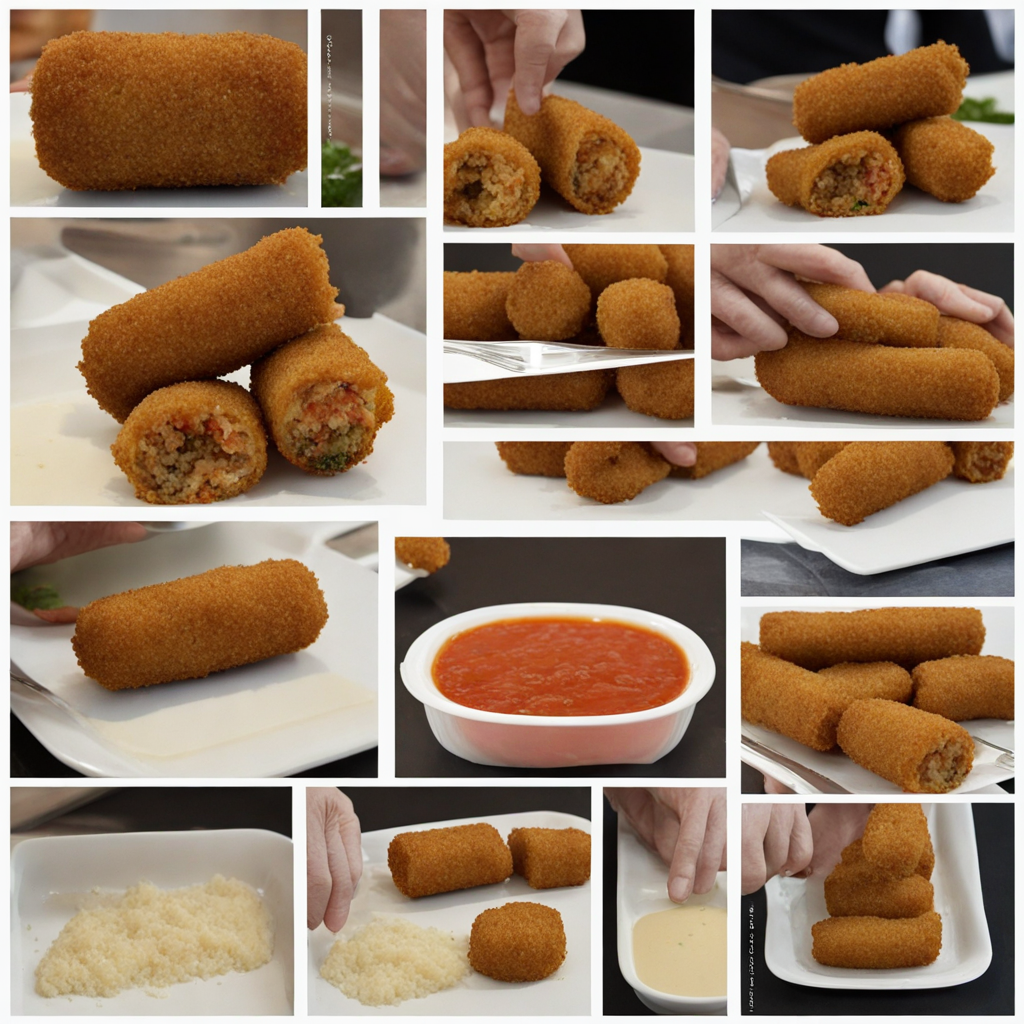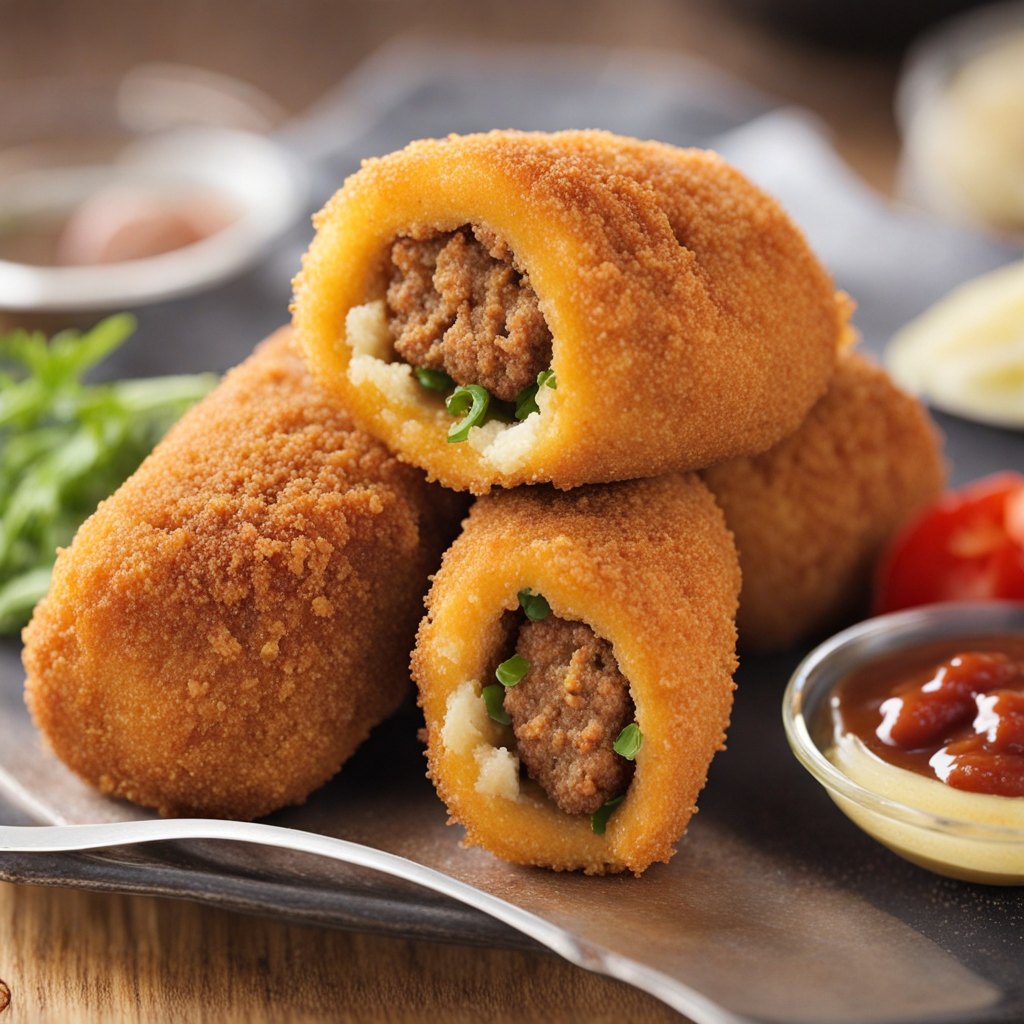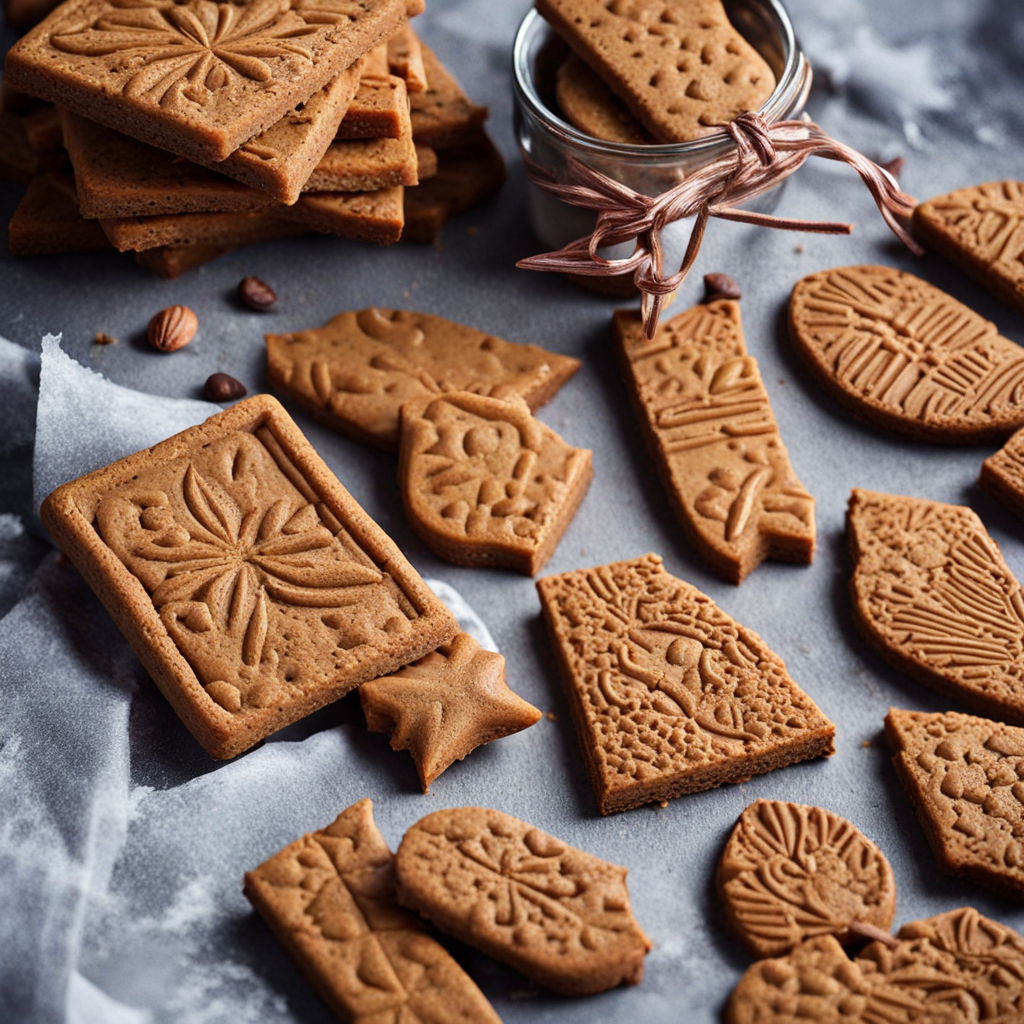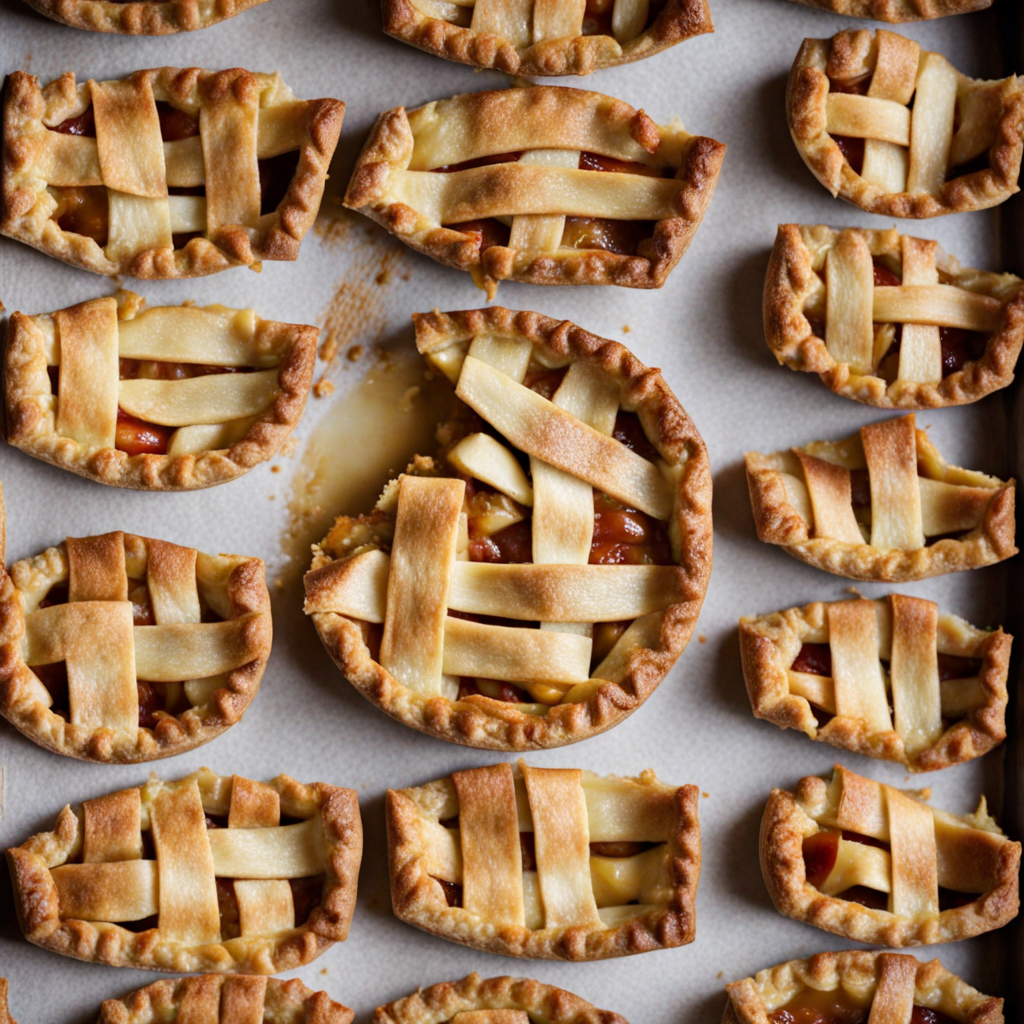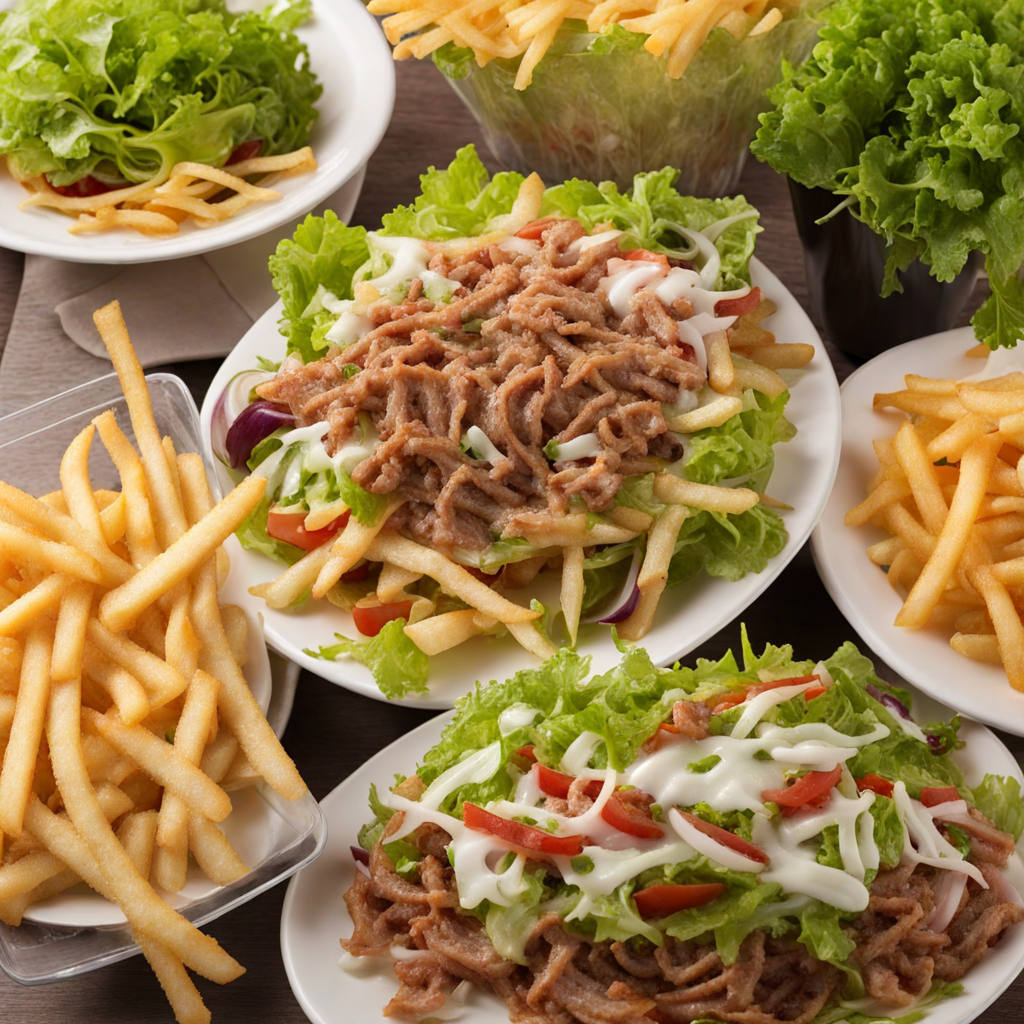Kroket
Kroket is a beloved Dutch snack that embodies the essence of comfort food with its crispy exterior and rich, flavorful filling. Traditionally, it consists of a cylindrical shape that is coated in breadcrumbs and deep-fried to a golden perfection. The outer layer offers a satisfying crunch, while the inside reveals a creamy, savory filling that often includes ragout made from beef or chicken. The use of spices, such as nutmeg and pepper, adds a distinct depth of flavor that tantalizes the taste buds and invites you to savor every bite. What sets Kroket apart is its versatility; while the classic version is a meat-filled delight, there are numerous variations available to cater to different palates. Vegetarian options feature fillings made from mushrooms or cheese, allowing those who prefer plant-based fare to indulge in this Dutch staple. Each bite offers a delightful contrast between the warm, luscious filling and the crisp, golden shell, making it a perfect snack or side dish that is often enjoyed with a side of mustard for an extra kick of flavor. In the Netherlands, Kroket is more than just a snack; it is a cultural icon that can be found in cafes, snack bars, and even served as part of a meal. It is often paired with fries or enjoyed in a sandwich, showcasing its adaptability to various dining experiences. Whether you are a seasoned foodie or someone eager to explore new tastes, Kroket promises to deliver a unique culinary adventure that captures the heart of Dutch cuisine, leaving you craving more of its irresistible charm.
How It Became This Dish
The History and Cultural Significance of Kroket in the Netherlands The *kroket*, a beloved Dutch snack, is more than just a deep-fried delicacy; it is a culinary symbol deeply embedded in the cultural fabric of the Netherlands. Its history, rich in flavor and tradition, reflects the evolution of Dutch society, its culinary practices, and its appreciation for comfort food. #### Origins: A Culinary Journey The origins of the kroket can be traced back to the 18th century, during a time when French culinary influences permeated European kitchens. The word 'kroket' itself derives from the French term *croquette*, meaning 'to crunch' or 'to crisp.' The concept of taking leftover meat, mixing it with a binding agent, and then coating it with breadcrumbs before frying was not unique to the Netherlands; it was a practice shared across various European cuisines, particularly in France and Belgium. The earliest known recipe resembling the kroket appears in Dutch cookbooks from the late 19th century, where it was featured as a way to utilize leftover meat. Traditionally, a filling made from a mixture of meat, ragout, or sometimes fish, was encased in a thick béchamel or a similar sauce, rolled into a cylindrical shape, breaded, and deep-fried. By the late 1800s, kroketten had firmly established themselves in the Dutch culinary repertoire. #### Cultural Significance: A Snack for the Masses As the Netherlands underwent significant social and economic changes during the 19th and early 20th centuries, the kroket became emblematic of working-class sustenance. With the rise of industrialization, many workers sought quick, filling meals that could be consumed on the go. The portability of the kroket, combined with its affordability, made it an ideal choice for busy laborers. Street vendors began selling these crunchy delights, making them accessible to a wider audience. The kroket also gained prominence within the context of Dutch social gatherings and celebrations. It became a staple at parties, birthdays, and special occasions. Its popularity surged after World War II, a time when food scarcity had pushed people to find innovative ways to create hearty meals from limited resources. The kroket was not only a means of using up leftovers but also provided a sense of comfort and nostalgia, resonating with the collective memory of a nation rebuilding itself. #### Development Over Time: From Traditional to Modern Through the decades, the kroket has evolved in both form and flavor. The classic beef kroket remains a favorite, but the latter half of the 20th century saw the emergence of various regional and creative interpretations. Chicken, fish, vegetable, and even more avant-garde fillings began to appear, catering to changing tastes and dietary preferences. In the 1960s and 1970s, the rise of fast food culture brought new challenges and opportunities for the kroket. Fast casual restaurants and snack bars, known as *snackbars*, began to proliferate across the country, offering a variety of quick bites, with the kroket often being the star attraction. It was during this time that the iconic *kroketten* became synonymous with Dutch fast food, often served with a side of *frites* (fries) and a generous dollop of mayonnaise. In 2006, the introduction of the *kroket speciaal*, a variant topped with raw onions and curry ketchup, further solidified the kroket's status as a beloved comfort food. This combination became a symbol of Dutch street food culture, celebrating the rich flavors that could be found in simple, unpretentious dishes. #### The Rise of Gourmet Kroketten As the 21st century dawned, there was a revival of interest in artisanal and gourmet foods. Chefs began to experiment with the kroket, elevating it to new culinary heights. High-end restaurants started to feature gourmet kroketten on their menus, filled with exotic ingredients like duck confit, truffle, or even seafood. These modern takes on the classic dish appealed to a more sophisticated palate while still honoring the traditional roots of the kroket. Moreover, the kroket found its way into international cuisine, inspiring similar dishes in various countries. Variants of the kroket can now be found in places as far afield as Indonesia, where it was introduced during the colonial era and adapted with local flavors. This cross-cultural exchange illustrates the kroket's adaptability and enduring popularity. #### Kroket Today: A Culinary Icon Today, the kroket is more than just a snack; it has transcended its humble origins to become a culinary icon of the Netherlands. It is often featured in culinary festivals, celebrated in social media posts, and passionately debated among food enthusiasts regarding the best places to find the perfect kroket. In recent years, the Dutch government has even recognized the cultural significance of the kroket, with movements to preserve traditional recipes and techniques as part of the nation's food heritage. This initiative aligns with a broader trend in many countries to honor traditional foods and the stories behind them, ensuring that they remain part of the cultural narrative for future generations. #### Conclusion: The Kroket's Enduring Legacy The *kroket* stands as a testament to the Dutch spirit of innovation, adaptability, and resilience. From its origins in the 18th century to its status as a modern-day comfort food, the kroket encapsulates the essence of Dutch culinary heritage. It reflects the nation’s history, the evolution of its society, and the way food brings people together. As the world continues to change, the kroket remains a familiar and cherished presence in Dutch culture, a reminder of the simple joys of life, and a delicious connection to the past. Whether enjoyed at a bustling street vendor, a cozy snack bar, or a fine dining establishment, the kroket continues to delight taste buds and warm hearts, ensuring its place in the pantheon of beloved global snacks.
You may like
Discover local flavors from Netherlands


